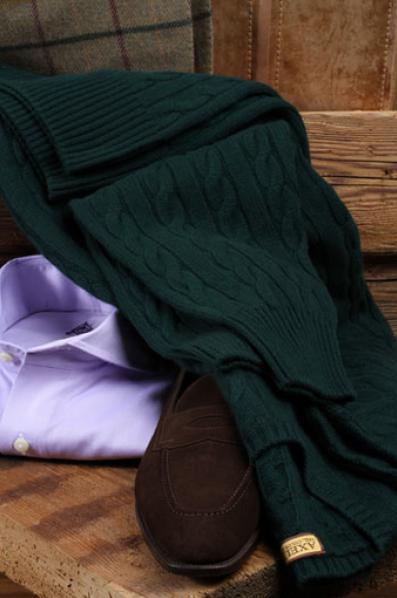
It is said by those who love good knitwear, and I suppose who have also been around long enough to know, that the best cashmere sweaters came by the way of Scotland prior to the 1990s. They never lost their shape or pilled, and they kept their whipped cream, puffy cloud goodness even after decades of hard wear. This is just what I’ve heard, of course. I was born in the late 1970s, and the softest thing I knew in the ‘80s was a stuffed light-brown koala bear with half closed eyes. He had sky blue t-shirt that said “World’s Greatest Friend,” which I wrote on him myself.
After the 1990s, the landscape of British knitwear manufacturing began to change. Beleaguered from years of struggling against Italian and Chinese competition, and failing to get government support, many companies were forced to close down or abandon their manufacturing standards. The story isn’t too unlike what happened with British eyewear manufacturing. Unlike in that industry, however, there are still a few high-quality British manufacturers left. These include John Laing, Hawick Cashmere, Thistle and Broom, and William Lockie. Hawick supplies the likes of Knize, Ben Silver, and Maus & Hoffman, while Lockie supplies knitwear to a number of storied Savile Row firms. Cashmere sweaters from these companies continue to be some of the coziest and hardest wearing around, and when they’re made into a timeless design – such as my favorite, the crewneck cable knit – they’ll genuinely last a lifetime.
The secret to good Scottish knitwear is in the raw materials and manufacturing process. The finest cashmere in the world comes from the Himalayan regions of India and Mongolia. The hairs are hand combed from goats, and the longest hairs are then selected out and spun into high-quality yarns. By using longer strands of hair, there are less “weak points” for the yarn to break, which is what causes pilling. These yarns are then sent to Scotland, generally around the region of Peeblesshire, where the region’s mineral water is said to give Scottish cashmere it unique softness. Additionally, garments are knit tightly. This ensures that the sweaters will retain their shape over time. Contrast this to lower-end manufacturers, who will knit garments loosely in order to save on cashmere, but at the cost of durability once the garment is pulled on and off the wearer over the period of years.
Of course, good cashmere cable knits from Scotland don’t come cheaply. I recently bought this grey John Laing piece from A Suitable Wardrobe, who happens to be one of my favorite vendors. The quality difference between this and my brand name cashmere cable knits (I’ll refrain from naming names) is obvious once you get to handle both. I would buy more, but A Suitable Wardrobe only stocks one color in my size. So I’m turning to William Lockie’s Chirnside for a navy and cream, which you can buy directly from Heather Wallace. Their sweaters are sized by the actual garment’s measurement. So a 42 inch sweater actually measures 21 inches from arm pit to arm pit. If you, like me, need something smaller, know that Lockie will custom knit you a sweater at no extra charge. Hawick Cashmere can also make you something custom, and they have many, many more colors, but they cost considerably more at $650 per sweater. For something more affordable than any of these options, you’ll have to learn how to trawl eBay for good cashmere. For that, I’ll refer you to Jesse Thorn, my colleague at Put This On, who wrote an excellent article on just that subject.
However you get them, I encourage you to stock up on a few as soon as you can. For one day, you might not be able to get good Scottish cashmere cable knits.
(Photos from Voxsartoria, A Suitable Wardrobe, and Axel’s)







